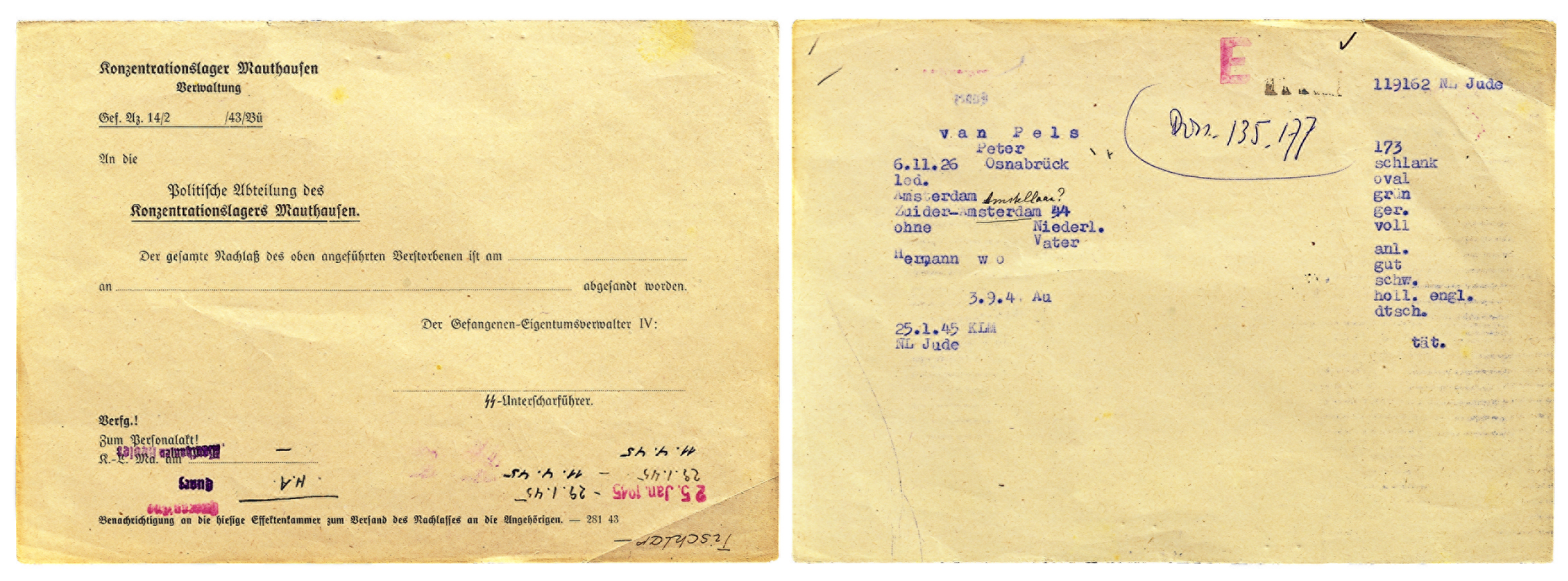Peter van Pels to Mauthausen
On 18 January 1945, Peter van Pels left Auschwitz, sent on one of the many death marches, the forced evacuations, mostly on foot, of prisoners that took place after the evacuation of concentration camps. After five days of walking and three days on the train, he arrived at the Mauthausen camp with 5.714 other prisoners.

De kaart van Peter van Pels uit Mauthausen. Op de voorgedrukte kant staan, ondersteboven, zijn beroep 'Tischler' en is bij gehouden waar hij gevangen heeft gezeten. Op de andere kant staan zijn persoonsgegevens.
Nationaal Archief, Den Haag Copyright: Publiek domein
On 18 January 1945, large columns of prisoners left Auschwitz from midnight until midday.[1] For Peter van Pels and about 5,700 others, the destination was camp Mauthausen in Austria.
The group covered the first 60-plus kilometres westward on foot.[2] It was a gruelling trek. Many of the prisoners were already severely weakened before they began the arduous march, and the SS guards shot and killed without mercy anyone who could not keep pace or tried to flee.
After five days on, 22 January 1945, they reached Loslau (now Wodzisław Śląsk on the Czech-Polish border).[2] There they were loaded per hundred prisoners into open coal or freight wagons that were full of snow and ice.[3] The train did not leave until the next morning. It was freezing twenty degrees and the prisoners were not given any food or drink. Many died during the journey from exhaustion and hypothermia. When the train stopped, the dead bodies were thrown outside.
After three days, they arrived at Mauthausen station. From there, the prisoners walked in a long file to the Mauthausen concentration camp.
Mauthausen was a camp of the toughest category.[4] The prisoners worked as forced labourers in the stone quarries of Mauthausen and Gusen. Due to the harsh regime and heavy work in the quarries, mortality rates were extremely high. It was a combination of labour and extermination. The prisoners literally worked themselves to death. The diet was calculated to have a life expectancy of three to four months.[5]
In Mauthausen's infamous quarry, the men of the penal commandos carried granite blocks on their backs along the steep stairs up in a wooden carrier. Medical care was poor. Jewish prisoners ended up as stone carriers in this punishment commando almost by default until 1944.
Footnotes
- ^ L. Landsberger, A. de Haas, K. Selowsky (red.), Auschwitz. Deel VI: De afvoertransporten uit Auschwitz en omgeving naar het noorden en het westen, en de grote evacuatietransporten, 's-Gravenhage: Hoofdbestuur van de Vereniging het Nederlandsche Roode Kruis, 1952, p. 3, 31, 85, en 227; NIOD Nederlands Instituut voor Oorlogs-, Holocaust- en Genocidestudies, 250d, inv.nr. 827, Verklaring C. Schimmer en A.F. van Velzen.
- a, b Zie bijv. kz-Gedenkstätte Mauthausen, amm oh/zp1/299, Interview Jakob Maestro, 17 juni 2002, 53. De beschrijving van de dodenmars hier is onder andere gebaseerd op de getuigenissen van Jakob Maestro, Job Jansen, Mari Sloot, Max Garcia, C. Schimmer, A.F. van Velzen.
- ^ Gebaseerd op de getuigenis van A.F. van Velzen.
- ^ Kampen werden ingedeeld naar Stufe I, II en III, waarbij Stufe iii het zwaarste regime was.
- ^ Ladislaus Szücs, Zählappell. Als Arzt im Konzentrationslager, Frankfurt am Main: Fischer Taschebuch, 1995, p. p. 34. Harald Hutterberger lichtte de berekening van calorieën mondeling toe.